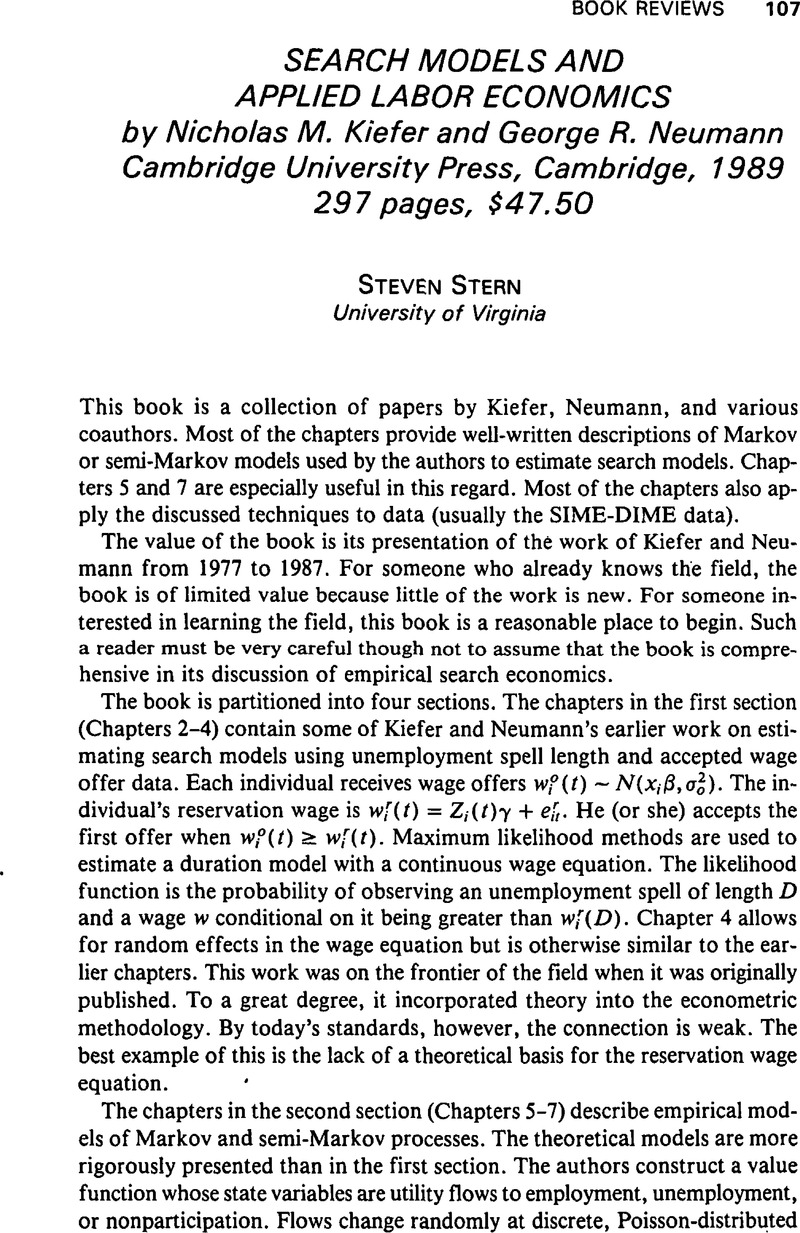No CrossRef data available.
Article contents
Search Models and Applied Labor Economics by Nicholas M. Kiefer and George R. Neumann Cambridge University Press, Cambridge, 1989297 pages, $47.50
Review products
Search Models and Applied Labor Economics by Nicholas M. Kiefer and George R. Neumann Cambridge University Press, Cambridge, 1989297 pages, $47.50
Published online by Cambridge University Press: 11 February 2009
Abstract
An abstract is not available for this content so a preview has been provided. Please use the Get access link above for information on how to access this content.

Information
- Type
- Book Reviews
- Information
- Copyright
- Copyright © Cambridge University Press 1990
References
1.Albrecht, J. & Axell, B.. An equilibrium model of search employment. Journal of Political Economy 92(5) (1984): 824–840.CrossRefGoogle Scholar
2.Berkovec, J. & Stern, S.. Job exit behavior of older men. Unpublished manuscript, University of Virginia, 1988.Google Scholar
3.Burdett, K. & Judd, K.. Equilibrium price dispersion. Econometrica 51(4) (1983): 955–970.CrossRefGoogle Scholar
4.Eckstein, Z. & Wolpin, K.. Dynamic labor force participation of married women and endogenous work experience. Unpublished manuscript, Ohio State University, 1986.Google Scholar
5.Eckstein, Z. & Wolpin, K.. Estimating a market equilibrium search model from panel data on individuals. Unpublished manuscript, Ohio State University, 1987.Google Scholar
6.Flinn, C. J. & Heckman, J. J.. Models for the analysis of labor force dynamics. In Vol. 1. Rhodes, G. and Basmann, R. (eds.), Advances in Econometrics, New London, CT: JAI Press.Google Scholar
7.Heckman, J. & Borjas, G.. Does unemployment cause future unemployment? Definitions, questions and answers from a continuous time model of heterogeneity and state dependence. Economica 47(187) (1980): 247–283.Google Scholar
8.Heckman, J. & Singer, B.. The identification problem in econometric models for duration data. In Hildenbrand, W. (ed.). Advances in Econometrics. Cambridge: Cambridge University Press, 1982.Google Scholar
9.Heckman, J. & Singer, B.. A method for minimizing the distributional assumptions in econometric models for duration data. Econometrica 52(1) (1984): 271–320.Google Scholar
10.Jovanovic, B.Job matching and the theory of turnover. Journal of Political Economy 87(5) (1979): 972–990.CrossRefGoogle Scholar
11.Lancaster, T.Econometric methods for the duration of unemployment. Econometrica 47(4) (1979): 939–956.Google Scholar
12.Meyer, B. “Semiparametric Estimation of Hazard Models.” Unpublished manuscript, Northwestern University.Google Scholar
13.Miller, R.Job matching and occupational choice. Journal of Political Economy 92(6) (1984): 1086–1120.CrossRefGoogle Scholar
14.Pakes, A.Patents as options: some estimates of the value of holding European patent stocks. Econometrica 54(4) (1986): 755–784.CrossRefGoogle Scholar
15.Reinganum, J.A simple model of equilibrium price dispersion. Journal of Political Economy 87(4) (1979): 851–858.Google Scholar
16.Rob, R.Equilibrium price distributions. Review of Economic Studies 47(3) (1980): 487–504.Google Scholar
17.Rothschild, M. (1980): Models of market organization with imperfect information: a survey. Journal of Political Economy 81(6) (1973): 1283–1308.CrossRefGoogle Scholar
18.Stern, S. The effects of firm optimizing behavior in matching models. Unpublished manuscript, University of Virginia, 1989.Google Scholar
19.Wilde, L.Labor market equilibrium under nonsequential search. Journal of Economic Theory (16) (1977): 373–393.Google Scholar
20.Wolpin, K.Estimating a structural search model: the transition from school to work. Econometrica 55(4) (1987): 801–818.Google Scholar

